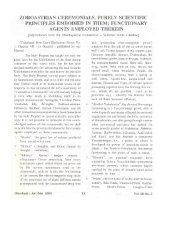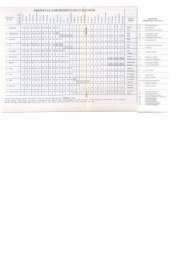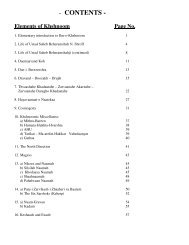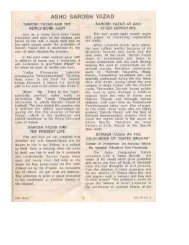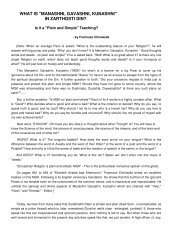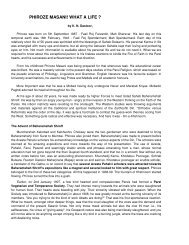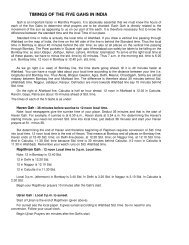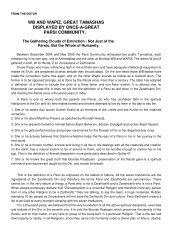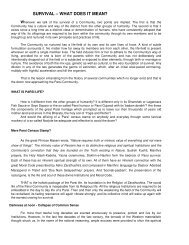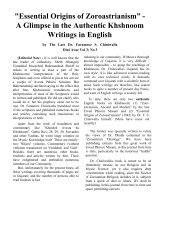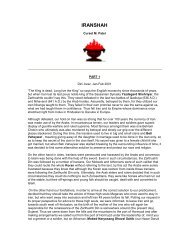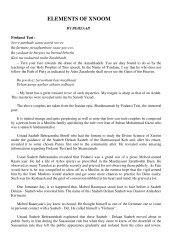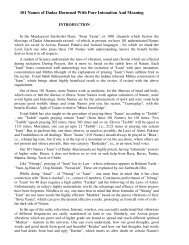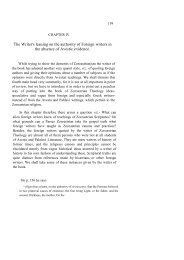the authentic key of ilm-e-khshnoom can alone open the door
the authentic key of ilm-e-khshnoom can alone open the door
the authentic key of ilm-e-khshnoom can alone open the door
You also want an ePaper? Increase the reach of your titles
YUMPU automatically turns print PDFs into web optimized ePapers that Google loves.
evidently an occult form <strong>of</strong> speech, have an inner meaning....<br />
Under pressure <strong>of</strong> <strong>the</strong> necessity to mask <strong>the</strong>ir meaning with symbols and symbolic words - for secrecy<br />
must be observed - <strong>the</strong> Rishis resorted to fix double meanings, a devise easily manageable in <strong>the</strong><br />
Sanskrit language where one word <strong>of</strong>ten bears several different meanings, but not easy to render in an<br />
English translation and very <strong>of</strong>ten impossible. Thus <strong>the</strong> word for cow 'go' meant also light or a ray <strong>of</strong><br />
light." (Compare Gav Chithra in Mah's Khshnooman). "…. When <strong>the</strong> Rishi asks Agni for "a horse-form<br />
cow - in - front gift' he is not asking really for a number <strong>of</strong> horses forming a body <strong>of</strong> <strong>the</strong> gift with some<br />
cows walking in front, he is asking for a great body <strong>of</strong> spiritual power led by <strong>the</strong> light or as we may<br />
translate it, with <strong>the</strong> Ray-Cow walking in front" (Compare <strong>the</strong> gift <strong>of</strong> ten pregnant mares and one Camel<br />
in Gatha Ha 44-18-k).<br />
{Dr. Saheb Chiniwalla now speaks about <strong>the</strong> Rules <strong>of</strong> (i) composing <strong>the</strong> Manthra and (ii) reading and<br />
understanding <strong>the</strong> Manthra :]<br />
There are laws for writing <strong>the</strong> three modes viz. Mithra, Manthra, Yasna. There was a Farhang<br />
(encyclopedia) i.e. an Ilm - a Branch <strong>of</strong> mystical knowledge, "Staota Yasna," which contained and elaborated<br />
those laws. Taavil Kalam-Kashi is easy enough to understand. (You grasp it as you read it). Zend mode <strong>can</strong><br />
convey a surface concept (like cow or horse or milk), but that writing is mythical or symbolic, which is to be<br />
converted to Taavil to understand it correctly. [Both <strong>the</strong>se - Taavil and Zend are <strong>the</strong> divisions <strong>of</strong> Mithra -<br />
Mode]. The word "Razeyng" is used for such wititngs.<br />
Thus <strong>the</strong> Ilm <strong>of</strong> Stota Yasna was highly valuable and fruitful. Explanations for many matters was<br />
obtainable from it. It was a collective - encyclopedic - Ilm, which <strong>can</strong> be used by <strong>the</strong> method <strong>of</strong> Index reading.<br />
It revealed how to write in different modes.<br />
Staota Yasna was also a Yashta, like <strong>the</strong> 23 Yashta's we have, which are not as complete as <strong>the</strong><br />
originals. Every Yashta is composed <strong>of</strong> such Manthra as would reveal <strong>the</strong> functions <strong>of</strong> a particular Yazata in<br />
<strong>the</strong> three worlds viz. Hasti, Nisti, Gayti, respectively named as Humata, Hukhta, Havrashta. Similarly <strong>the</strong><br />
Staota Yashta revealed what functions <strong>the</strong> STAOTA i.e. <strong>the</strong> Nature's Vibrations have in Hasti, Nisti and Geyti<br />
(Divine, ultra-physical and physical). The constitution and function <strong>of</strong> every thing (every particle corpuscule,<br />
globule, drop or point whatsoever in space and time or beyond space and time) are, and arise from, 'Stota'<br />
<strong>the</strong> Vibration.<br />
[Staota Yasna is <strong>the</strong> grand mechanism <strong>of</strong> all Vibrations in Nature. All and every Creation <strong>of</strong> Ahura<br />
vibrates with His Divine Energy, which is Atash. The Divine Science <strong>of</strong> <strong>the</strong>se Vibrations is Staota Yasna.]<br />
[In Avan Niyaish <strong>the</strong>se words occur: "Ya Ahmat Staot Yasan Sravyeni" – "I do sing, for Her (Aradvi),<br />
Staota Yasna." The present day scholars are on a guesswork spree as to what is this Staota Yasna to be<br />
sung. They think it is Staota Yashta, which is <strong>the</strong> name <strong>of</strong> <strong>the</strong> 21st Nask, corresponding to <strong>the</strong> last word<br />
"Vaastaareym" <strong>of</strong> Yathaa Ahu Vairyo Prayer. And here is <strong>the</strong> sprinkler <strong>of</strong> scholarly conjectures - K. R. Cama<br />
thinks Satood Yashta must be Yazashney Ha's 58, 59; Shaheriyarji Bharucha, Yaz. Ha's 58, 59, 60;<br />
Darmesteter, Yaz Ha's 14 to 58; Kangaji, Yaz. Ha's 28 to 51 and Ha 53 - i.e. <strong>the</strong> Five Gatha's and Haptan<br />
Yashta. In truth it was a full separate Nask with 33 Chapters, containing <strong>the</strong> composition, constitution and<br />
functions <strong>of</strong> all <strong>the</strong> Vibrations in Hasti, Nisti and Geyti. This information flows from IIm-e-Khshnoom; but it will<br />
be more convincing than <strong>the</strong> wild guess-works <strong>of</strong> <strong>the</strong> scholars, if we put toge<strong>the</strong>r all <strong>the</strong> references to Staota<br />
Yasna in <strong>the</strong> existing Avesta, particularly, Yazashney Ha's 55 and 71. The cumulative effect <strong>of</strong> all <strong>the</strong><br />
references do support and lead to <strong>the</strong> said Khshnoomic information.]<br />
REFERENCES OF STAOTA YASNA IN GATHA<br />
In this 200 pages long Gujerati book "Gatha Haa 30" (Parsi Vegetarian & Temperance Society - 1941),



